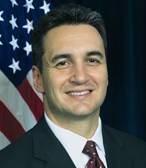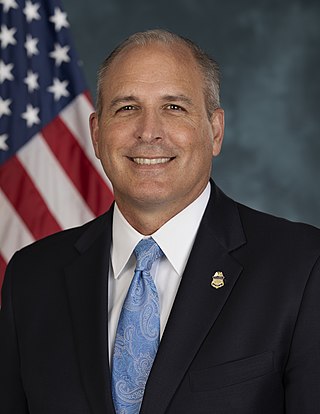Early career
Torres began his law enforcement career with the former Immigration and Naturalization Service (INS) in 1986. During his time in the former INS,Torres played several key roles. Early in his career,Torres was a decorated member of a highly successful undercover investigative unit in Los Angeles. In 1992 during the Los Angeles riots,he was assigned to duty at the Newton and Rampart Divisions of the Los Angeles Police Department.
In 1999,Torres was designated the INS investigative lead for the railway serial killer investigation of Rafael Resendez-Ramirez in Texas. In 1997,Torres was assigned to the FBI Headquarters International Terrorism Operations Section,and later designated as the first INS Special Agent in the Osama bin Laden Unit. In that capacity,he managed investigations of the East Africa embassy bombings,the millennium attack plot to bomb the Los Angeles International Airport and other sites,the Khobar Towers attack,and the plot to bomb American airliners over the Pacific Ocean. Following the 9/11 attacks,Torres returned to Washington and was assigned to the subsequent investigation at FBI headquarters.
In addition to being a key member of several investigations,Torres also developed the Law Enforcement Support Center in Burlington,Vermont,which has become an integral piece to coordination between ICE and other law enforcement agencies.
Career at ICE
From March to November 2008,John Torres was the Deputy Assistant Secretary for Operations for U.S. ICE. In this capacity,Torres was responsible for coordinating the efforts of the Office of Federal Protective Service (FPS),the National Firearms and Tactical Training Unit,the National Incident Response Unit,the Office of Detention and Removal Operations (DRO),the Office of Intelligence,the Office of International Affairs,the Office of Investigations (OI),and the Office of State and Local Coordination. Torres worked to ensure the most effective collaboration between each of these operational components of ICE in an effort to achieve the stated goals of the agency,and to realize the most efficient use of the agency's resources toward that end.
From June 2005 to March 2008,John Torres was the Director of the Office of Detention and Removal Operations for ICE within the Department of Homeland Security. In his capacity as Director,Torres oversaw an authorized workforce of more than 6,700 employees,including nearly 6,000 sworn law enforcement officers assigned to 24 field offices nationwide,managed an operating budget of over $2 billion,ended the practice of "catch and release" and transitioned the Criminal Alien Program from the Office of Investigations to DRO. In Fiscal Year 2007,DRO removed over 282,000 foreign nationals;eliminated more than 140,000 fugitive cases from the fugitive backlog;issued 164,296 charging documents through the Criminal Alien Program;and expanded detention capacity to 27,500 from 18,500 in Fiscal Year 2005.
Torres previously served as Deputy Assistant Director for Smuggling and Public Safety in ICE Office of Investigations,where he oversaw the implementation of ICE's anti-gang initiative Operation Community Shield,the ICE Mutual Agreement between Government and Employers (IMAGE) program,and the establishment of ICE's Document and Benefit Fraud task forces. He previously served as the Special Agent-in-Charge of the Newark ICE office,where he oversaw ICE's participation in several major multi-agency investigations,including an international child pornography investigation resulting in the arrests of over 2,000 people;and an undercover investigation involving the purchase of surface-to-air missiles from arms brokers for the purpose of downing American airliners.

The United States Department of Homeland Security (DHS) is the U.S. federal executive department responsible for public security, roughly comparable to the interior or home ministries of other countries. Its stated missions involve anti-terrorism, border security, immigration and customs, cyber security, and disaster prevention and management.

The United States Immigration and Naturalization Service (INS) was an agency of the U.S. Department of Labor from 1933 to 1940 and the U.S. Department of Justice from 1940 to 2003.
U.S. Immigration and Customs Enforcement (ICE) is a federal law enforcement agency under the U.S. Department of Homeland Security. ICE's stated mission is to protect the United States from the cross-border crime and illegal immigration that threaten national security and public safety.

The United States Customs Service was the very first federal law enforcement agency of the U.S. federal government. Established on July 31, 1789, it collected import tariffs, performed other selected border security duties, as well as conducted criminal investigations.

United States Customs and Border Protection (CBP) is the largest federal law enforcement agency of the United States Department of Homeland Security. It is the country's primary border control organization, charged with regulating and facilitating international trade, collecting import duties, as well as enforcing U.S. regulations, including trade, customs and immigration. CBP is one of the largest law enforcement agencies in the United States. It has a workforce of more than 45,600 federal agents and officers. It is headquartered in Washington, D.C.

Julie Lyn Myers Wood is an American prosecutor and former government official. She was the Assistant Secretary of Homeland Security for Immigration and Customs Enforcement. She assumed the job following a recess appointment by President George W. Bush on January 4, 2006. Previously, Myers worked for the Office of Independent Counsel under Kenneth Starr and was a lead prosecutor in the Independent Counsel's failed case against Susan McDougal. She is currently CEO of Guidepost Solutions, LLC, a leading investigative and compliance consulting firm.
U.S. Citizenship and Immigration Services (USCIS) is an agency of the United States Department of Homeland Security (DHS) that administers the country's naturalization and immigration system. It is a successor to the Immigration and Naturalization Service (INS), which was dissolved by the Homeland Security Act of 2002 and replaced by three components within the DHS: USCIS, Immigration and Customs Enforcement (ICE), and Customs and Border Protection (CBP).

The Border Patrol Tactical Unit (BORTAC) is the tactical unit of the United States Border Patrol. In 2007, BORTAC was placed under the command of the newly formed Special Operations Group (SOG) together with the Border Patrol Search, Trauma, and Rescue Unit (BORSTAR).

The Orange County Sheriff's Department (OCSD) is the law enforcement agency serving Orange County, California. It currently serves the unincorporated areas of Orange County and thirteen contract cities in the county: Aliso Viejo, Dana Point, Laguna Hills, Laguna Niguel, Laguna Woods, Lake Forest, Mission Viejo, Rancho Santa Margarita, San Clemente, San Juan Capistrano, Stanton, Villa Park, and Yorba Linda.

Michael John Garcia is an American lawyer, judge and former Republican government official. Since February 2016, he has served as an Associate Judge of the New York Court of Appeals, that state's highest court. He is a former U.S. Attorney for the Southern District of New York (2005–2008). Between his service as United States Attorney and his appointment to the Court of Appeals, Garcia was a partner at the law firm Kirkland & Ellis. He has also served as chairman of El Museo del Barrio.
Operation Endgame was a 2003–2012 plan under implementation by the Office of Detention and Removal Operations of the United States Department of Homeland Security Bureau of Immigration and Customs Enforcement to detain and deport all removable aliens and "suspected terrorists" currently living in the United States by 2012.
The Office of Immigration Statistics (OIS) is an agency of the United States Department of Homeland Security under the Office of Strategy, Policy, and Plans.

The United States government holds tens of thousands of immigrants in detention under the control of Customs and Border Protection and the Immigration and Customs Enforcement (ICE). Immigrants are detained for unlawful entry to the United States, when their claims for asylum are received, and in the process of deportation and removal from the country. During Fiscal Year 2018, 396,448 people were booked into ICE custody: 242,778 of whom were detained by CBP and 153,670 by ICE's own enforcement operations. A daily average of 42,188 immigrants were held by ICE in that year. In addition, over twelve thousand immigrant children are housed by facilities under the supervision of the Office of Refugee Resettlement's program for Unaccompanied Alien Children. Prior to referral to these other agencies, the CBP holds immigrants at processing centers; between mid-May and mid-June 2019, it held between 14,000 and 18,000 immigrants.

The National Intellectual Property Rights Coordination Center (NIPRCC) is a U.S. government center overseen by U.S. Immigration and Customs Enforcement, a component of the U.S. Department of Homeland Security. The NIPRCC coordinates the U.S. government's enforcement of intellectual property laws.

Mark A. Morgan is an American law enforcement official who served as the Chief Operating Officer and acting Commissioner of U.S. Customs and Border Protection from July 5, 2019, to January 20, 2021.

Jaime Jorge Zapata was an Immigration and Customs Enforcement, Homeland Security Investigations Special Agent who was ambushed and murdered by the Mexican criminal group Los Zetas in San Luis Potosí, Mexico. He was one of two agents who were ambushed in a part of the country that was increasingly under the influence of drug violence. Zapata's death was the second highest-profile killing of a U.S. agent in Mexico—the first one was Enrique Camarena, an undercover DEA agent who was tortured and murdered by the former Guadalajara Cartel.

Operation Community Shield is an ongoing multi-agency law enforcement initiative targeting violent gang members and their associates involved in the illegal drug and human trafficking industries in the United States. Since its launch by U.S. Immigration and Customs Enforcement (ICE) in February 2005, Homeland Security Investigations (HSI) and other participating federal, state and local law enforcement agencies have made more than 40,000 gang-related arrests, including 451 gang leaders, representing more than 2,400 different gangs and organizations, and have seized more than 8,000 guns in multiple projects.

James A. "Jim" Dinkins is an American law enforcement officer and business executive who served as the first head of Homeland Security Investigations for U.S. Immigration and Customs Enforcement from 2010 to 2014. He is a senior vice president and director of operations of Enterprise Financial Crimes Compliance for U.S. Bancorp.

The Director of the U.S. Immigration and Customs Enforcement (ICE) is a civilian official in the United States Department of Homeland Security. During July 2010 the position's title was changed from Assistant Secretary for U.S. Immigrations and Customs Enforcement.
In 2011, the U.S. Immigration and Customs Enforcement Agency revised its national detention standards and developed the Performance-Based National Detention Standards. According to U.S. Immigration and Customs Enforcement, "the PBNDS 2011 are crafted to improve medical and mental health services, increase access to legal services and religious opportunities, improve communication with detainees with no or limited English proficiency, improve the process for reporting and responding to complaints, and increase recreation and visitation." The PBNDS of 2011 is an important step in United States detention reform. Many revisions reflect efforts to tailor detention practices to the United States border's unique demands and circumstances. The PBNDS of 2011 revised detention standards among seven different sections. Although all sections detail essential contributions to improving the safety, security, order, care, activities, justice, and administration/management of U.S. border control, there are sections pertaining to the specific conditions of undocumented women.














